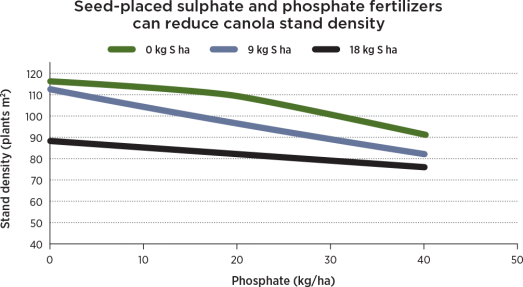Put only phosphate in the seed row
Key practice: Ensure safe rates of seed-placed fertilizer to improve nutrient-deficient soil conditions without increasing seedling mortality. The safest step is to put only phosphate in the seed row, and all other fertilizer outside the seed row.
Key research: Grant, Cynthia, Agriculture and Agri-Food Canada (AAFC). “Improving Nutrient Management in Canola and Canola-Based Cropping Systems.” Canola Digest Science Edition (2013).
Grenkow, Laryssa, University of Manitoba. “Seed-Placed Phosphorus and Sulphur Fertlizers: Effect on Canola Plant Stand and Yield.” Oral Presentations, Soils and Crops (2013).
The success of a canola crop relies on meeting high nutrient requirements, particularly those of nitrogen (N), phosphorus (P) and sulphur (S), as well as establishing a strong, dense plant stand. Putting down seed and fertilizer in one pass is common practice on the Prairies, but for canola, most of that fertilizer should go in the side band or mid-row band to avoid seed damage and seedling mortality.
Safe seed placement rates depend on row spacing, seed and fertilizer placement and separation, soil moisture and soil type. Phosphorus is the most important nutrient to place in the seed row, due to its limited mobility and the importance of early uptake.
Seed row placement is best for the first 15 to 20 lb./ac. of phosphate as it may improve emergence and seedling vigour on deficient or cool soils where availability is reduced.
Laryssa Grenkow, then with the University of Manitoba, presented, “Seed-Placed Phosphorus and Sulphur Fertilizers: Effect on Canola Plant Stand and Yield,” at Soils and Crops 2013. This presentation was based on the findings of a Canola-Flax Agri-Science Cluster study led by Cynthia Grant of AAFC, Brandon, MB. The study evaluated improved practices for P, S and N management in canola. Field, growth chamber and laboratory trials were used to determine safe rates of seed-placed P and S blends in various environments and the effects of traditional versus enhanced-efficiency P and S fertilizers on canola variables.
For most site years, the field study application of traditional ammonium sulphate (AS) or monoammonium phosphate (MAP) alone at either rate did not affect stand establishment. Applying P and S fertilizers in a blend increased the frequency and severity of damage with plant stand reduction by as much as 57 percent and by an average of 18 percent overall. The high-AS blends caused the most damage, resulting in an overall average plant stand reduction near 20 percent (see the figure).
As for yield, the greatest and most consistent yield increase resulted from the combination high-MAP/low-AS treatment. However, due to a high salt index, seed row application that includes AS does come with a high risk of ammonia toxicity.
Grenkow concluded that, “In order to maximize the benefits and minimize the risks of applying highly available P and S, farmers with single shoot, low SBU seeding equipment should reserve the limited tolerance of canola for seed row fertilizer for P.”





